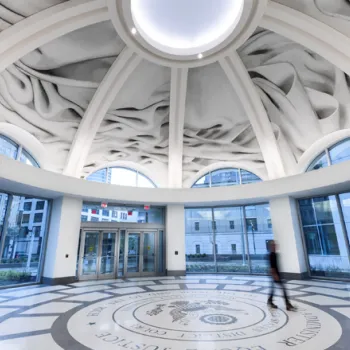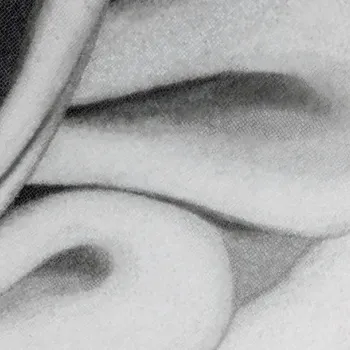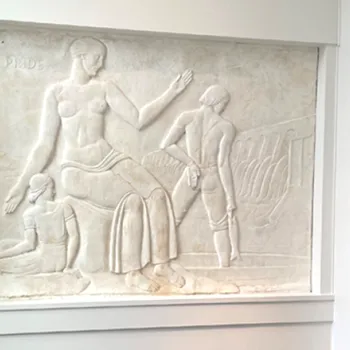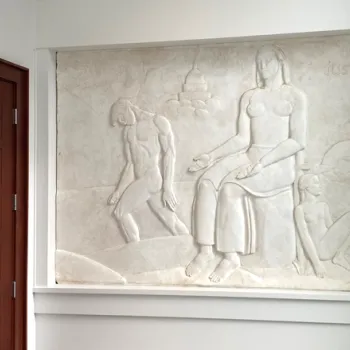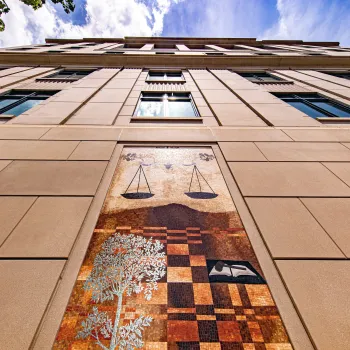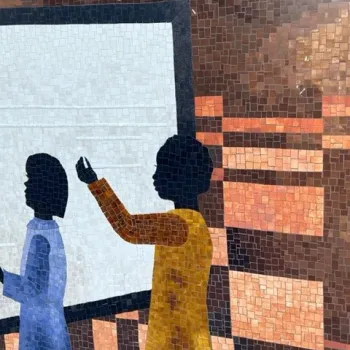Visitors to the new courthouse in downtown Nashville may arrive with nothing but court business in mind, but some of them leave feeling inspired by the work of Leo Friedlander, the mid-century artist known for his prominent public commissions.
Two plaster panels placed on either end of the sixth-floor corridor of the Fred D. Thompson U.S. Courthouse and Federal Building are full-scale models of never-completed granite reliefs that Friedlander designed in 1950 to flank the entrance of the Estes Kefauver Federal Building and Courthouse Annex in Nashville. The plaster panels were long forgotten in storage in the old federal building until 1989, when they were rediscovered. They were restored, and now reside in the new Fred D. Thompson building that opened in May.
Several new courthouses coming online as a result of a $948 million investment by Congress in recent years are similarly getting an aesthetic touch thanks to the federal government’s Art in Architecture program. Run by the General Services Administration (GSA), the agency responsible for building courthouses and other federal buildings, the program makes it possible to display museum-quality artwork in places frequented by the public “to create a lasting cultural legacy for the nation,” the GSA says.
“At their best, public art projects at courthouses invite those who are passing by or through the courthouse to pause and reflect on that art. It may draw a smile or an angling of the head,” said U.S. District Judge Jeffrey J. Helmick, who chairs the Judicial Conference’s Space and Facilities Committee. “The projects can reflect the history and flavor of the region. They can honor the identity of the community in a way to make its residents proud. And they can tie a federal building to the very local community in which it sits.”
The artists are chosen from a National Artist Registry, a database of American artists who have submitted samples of their work to be reviewed by panels of experts for possible selection. Artists who receive commissions work with the building architects and others in a collaborative design team to integrate the artwork into the overall plan for a building. The program is funded by setting aside one half of 1 percent of a project’s estimated construction cost for the art.
The Friedlander installation in Nashville is imbued with local history and meaning. On one end of the corridor, a mural-sized relief titled State Pride illustrates important industries in Tennessee, with a factory on the left and a hydroelectric dam on the right. The companion panel at the opposite end of the corridor depicts the allegorical figure of Justice presiding over an idyllic landscape, with the dome of the U.S. Capitol in the background.
Friedlander was a sculpture professor at New York University who designed reliefs representing radio and television for the Rockefeller Center in 1939 and the two 1951 massive bronze sculptures titled Valor and Sacrifice, featuring the ancient Roman god of war on horseback, at the entrance to the Arlington Memorial Bridge in Washington, D.C.
A visually spectacular, second installation at the Nashville courthouse is incorporated into the soaring dome that is the first thing people notice when entering the courthouse. Artist Alyson Shotz designed a mosaic for the dome ceiling of the undulating folds in the robes of Justitia, the Roman goddess of justice who is often depicted wearing flowing robes in classical sculpture and oil painting. The mosaic consists of millions of separate pieces of glass juxtaposed to create the image of Justitia’s robes.
District Judge Aleta Arthur Trauger, who was involved in the courthouse project, said, “Visitors are immediately enveloped by the mosaic in the rotunda as they enter the new space, which personifies the goal on the rotunda’s terrazzo floor ‘To Administer Equal Justice to the Poor and to the Rich.’”
Other recent art installations in new courthouses likewise strive to incorporate civic meaning and familiar concepts in the American justice system.
San Antonio, Texas
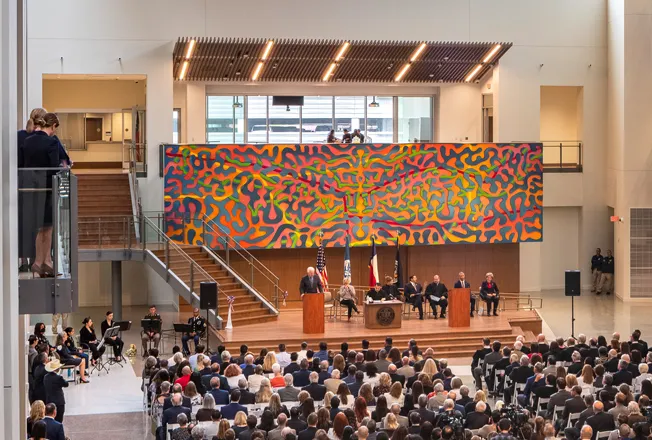
A vibrant mural by artist Thomas Glassford serves as a visual focal point for the courthouse atrium. The title Riparian Nexus means a “network of waterways,” inspired by the local landscape. Credit: Robert Gomez.
Laredo-born artist Thomas Glassford designed twin suspended sculptures for the Western District of Texas courthouse, one hung on the outside of the building and one on the inside, both viewable through a floor to ceiling window. The exterior work is a gilded-bronze abstract sculpture and the interior work consists of a string of colorful glass forms that drop from the atrium ceiling. Viewed together, they represent the scales of justice.
A second work by the artist is a large mural in the atrium, a central gathering point in the new courthouse. Glassford used current and historical maps of San Antonio-area roads and waterways as his inspiration for the abstract painting. The courthouse is adjacent to San Pedro Creek, the source for 45 miles of manmade irrigation channels that fueled the growth of San Antonio, known for its downtown River Walk.
District Judge Xavier Rodriguez, who helped guide the courthouse project, said that the inclusion of the city’s famous waterways in the piece speaks to him of “letting justice flow like rivers of righteousness.”
Rodriguez likes the idea that the mural sits right below the jury assembly area, creating an allegory to justice flowing from juries to people seeking justice in court. The mural and the sculptures also add much-needed color to the interior space, he said.
“Courthouses can oftentimes be intimidating places,” he said. “Adding art elements can make the courthouse feel more welcoming and accessible. The mural adds vibrancy and color to the space, yet it’s respectful and has meaning to the community that the courthouse serves.”
Charlotte, North Carolina
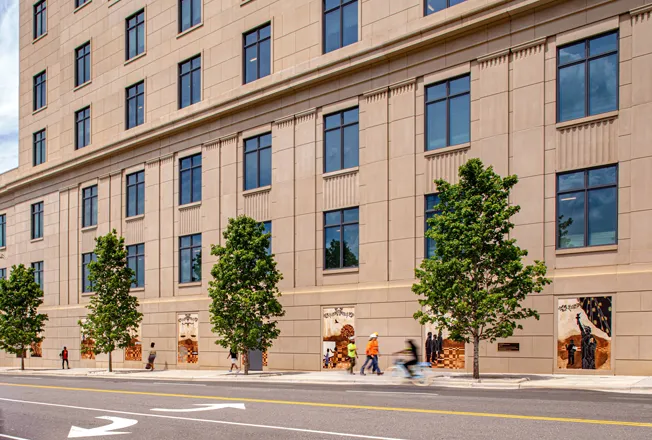
Seven mosaic works by artist Ellen Driscoll grace the outside walls of the new courthouse annex, allowing all who pass to view snippets of everyday life in North Carolina. Credit: Sean Busher.
The Charles R. Jonas Federal Building underwent a major renovation and an annex was added to the circa 1918 structure, work that is slated to be completed in the fall. Brooklyn-based artist Ellen Driscoll created a seven-panel mosaic for the exterior of the annex, with each panel depicting historically significant aspects of life in the Western District of North Carolina.
There are representations of a U.S. Mint office, a postal carrier, children in school, and a military recruitment center where a soldier is shown saluting an American flag. A strand of garland appears at the top of each panel, serving to unite the seven pieces in a single story of the region, anchored by Charlotte.
“The seven mosaics are amazing, and they are especially beautiful when lit at night,” said Judge Robert J. Conrad, Jr., the building renovation and project judge for the court. “I believe it will become an iconic part of the city.”
Greenville, South Carolina
Dive Deeper
Learn more about one of the largest modernizations of federal courthouses in recent decades.
Artist Joyce Kozloff created a work celebrating the history of mapmaking and the Upstate South Carolina region’s history as a hub of textile production in the United States. Her suite of 17 ceramic tile and glass mosaic panels depict present-day Google Earth aerial views of textile mills. At the top of each map, the artist painted a textile pattern that was produced at the mill. The maps are paired with textile artwork that was traditionally handmade by women in the region, such as quilts made in the 19th Century.
Incorporating artwork into public spaces dates to the mid-19th Century, when murals and sculptures were commissioned for federal buildings and reflected a bias in favor of European artists and styles, according to GSA’s history of the Art in Architecture program. The New Deal in the 1930s created federal arts programs emphasizing American artists and architects, reflecting “a desire to establish a distinctly American national culture.”
Subscribe to News Updates
Subscribe to be notified when the news section is updated.

